You are using an out of date browser. It may not display this or other websites correctly.
You should upgrade or use an alternative browser.
You should upgrade or use an alternative browser.
Heatstick = awesome!
- Thread starter BackBayBrewing
- Start date

Help Support Homebrew Talk:
This site may earn a commission from merchant affiliate
links, including eBay, Amazon, and others.
I have a question and I think I know the answer but feel stupid enough to ask it anyways. I have a 20 amp circuit in my garage, I know because I put in the 12g wire and I know the breaker is 20amp, it is also GFI but the question is that it has a standard style outlet (put in by the builder), meaning 2 vertical and ground opposed to the styles on saw on here with 1 vertical, 1 horizontal and ground.
Can I use the outlet as is for 20 amp or do I need to get a new outlet and corresponding plugs etc....
Can I use the outlet as is for 20 amp or do I need to get a new outlet and corresponding plugs etc....
I would not recommend using a 15a outlet for 20a. That may not be safe even though the manufacturer needs to engineer in a margin of safety. I.e., if I were to (hypothetically of course) push 22a @220v through a15a 120v rated plug (hardwired to my hlt) it would get warm to the touch, but still work fine. I would keep an extinguisher nearby and NEVER leave it alone or place it near combustibles All hypothetical here 
Long story short... no-one is going to recommend you do something potentially unsafe, that is your decision. My bigger concern would be destroying the gfci. They are very sensitive and degrade with abuse. A failure would possibly ruin an entire batch.
Long story short... no-one is going to recommend you do something potentially unsafe, that is your decision. My bigger concern would be destroying the gfci. They are very sensitive and degrade with abuse. A failure would possibly ruin an entire batch.
wilserbrewer
BIAB Expert Tailor
Most modern kitchens built in the last 20 years have at least one and likely two 20 amp outlets on dedicated circuits. The newer 20 amp horizontal plugs are for specific large draw 120v tools like a table say or floor sander, btw I have never seen an appliance with the 120v 20a style plug?
From what I have read, there is no great danger in drawing 17 or 18 amps from an outlet on a 20 amp service, but I would like to hear more information from those in the know.
These specific plugs are intended to prohibit plugging a large draw 20 amp appliance into a 15 amp circuit, and not necessarily the opposite application.
20 amp 120v outlet in my kitchen.

Wilserbrewer
Http://biabbags.webs.com/
From what I have read, there is no great danger in drawing 17 or 18 amps from an outlet on a 20 amp service, but I would like to hear more information from those in the know.
These specific plugs are intended to prohibit plugging a large draw 20 amp appliance into a 15 amp circuit, and not necessarily the opposite application.
20 amp 120v outlet in my kitchen.

Wilserbrewer
Http://biabbags.webs.com/
Most modern kitchens built in the last 20 years have at least one and likely two 20 amp outlets on dedicated circuits. The newer 20 amp horizontal plugs are for specific large draw 120v tools like a table say or floor sander, btw I have never seen an appliance with the 120v 20a style plug?
From what I have read, there is no great danger in drawing 17 or 18 amps from an outlet on a 20 amp service, but I would like to hear more information from those in the know.
These specific plugs are intended to prohibit plugging a large draw 20 amp appliance into a 15 amp circuit, and not necessarily the opposite application.
20 amp 120v outlet in my kitchen.
View attachment 217362
Wilserbrewer
Http://biabbags.webs.com/
Yes, that is what I have, I have a home built in 2013 and all circuits have a GFI outlet on the circuit somewhere and also there are several 20a circuts to places like the bathrooms and kitchen
So is there any recent updates on what sealant to use? Are people happy with JB weld as far as longevity/strength and the fear of putting something unwanted into the wort? Or is there a better alternative?

$172.35
2 Inch Tri Clamp Keg Manifold With Ball Lock Posts, Pressure Gauge, PRV (0-30 PSI) – Homebrew, Fermentation, Kegging System
wuhanshijiayangzhiyimaoyiyouxiangongsi

$7.79 ($7.79 / Count)
Craft A Brew - LalBrew Voss™ - Kveik Ale Yeast - For Craft Lagers - Ingredients for Home Brewing - Beer Making Supplies - (1 Pack)
Craft a Brew
![Craft A Brew - Safale S-04 Dry Yeast - Fermentis - English Ale Dry Yeast - For English and American Ales and Hard Apple Ciders - Ingredients for Home Brewing - Beer Making Supplies - [1 Pack]](https://m.media-amazon.com/images/I/41fVGNh6JfL._SL500_.jpg)
$6.95 ($17.38 / Ounce)
$7.47 ($18.68 / Ounce)
Craft A Brew - Safale S-04 Dry Yeast - Fermentis - English Ale Dry Yeast - For English and American Ales and Hard Apple Ciders - Ingredients for Home Brewing - Beer Making Supplies - [1 Pack]
Hobby Homebrew

$39.22 ($39.22 / Count)
Brewer's Best Home Brew Beer Ingredient Kit - 5 Gallon (Mexican Cerveza)
Amazon.com

$10.99 ($31.16 / Ounce)
Hornindal Kveik Yeast for Homebrewing - Mead, Cider, Wine, Beer - 10g Packet - Saccharomyces Cerevisiae - Sold by Shadowhive.com
Shadowhive

$22.00 ($623.23 / Ounce)
AMZLMPKNTW Ball Lock Sample Faucet 30cm Reinforced Silicone Hose Secondary Fermentation Homebrew Kegging joyful
无为中南商贸有限公司

$53.24
1pc Hose Barb/MFL 1.5" Tri Clamp to Ball Lock Post Liquid Gas Homebrew Kegging Fermentation Parts Brewer Hardware SUS304(Gas MFL)
Guangshui Weilu You Trading Co., Ltd

$58.16
HUIZHUGS Brewing Equipment Keg Ball Lock Faucet 30cm Reinforced Silicone Hose Secondary Fermentation Homebrew Kegging Brewing Equipment
xiangshuizhenzhanglingfengshop

$33.95
Five Star - 6022b_ - Star San - 32 Ounce - High Foaming Sanitizer
Bridgeview Beer and Wine Supply

$53.24
1pc Hose Barb/MFL 1.5" Tri Clamp to Ball Lock Post Liquid Gas Homebrew Kegging Fermentation Parts Brewer Hardware SUS304(Liquid Hose Barb)
yunchengshiyanhuqucuichendianzishangwuyouxiangongsi

$176.97
1pc Commercial Keg Manifold 2" Tri Clamp,Ball Lock Tapping Head,Pressure Gauge/Adjustable PRV for Kegging,Fermentation Control
hanhanbaihuoxiaoshoudian

$33.99 ($17.00 / Count)
$41.99 ($21.00 / Count)
2 Pack 1 Gallon Large Fermentation Jars with 3 Airlocks and 2 SCREW Lids(100% Airtight Heavy Duty Lid w Silicone) - Wide Mouth Glass Jars w Scale Mark - Pickle Jars for Sauerkraut, Sourdough Starter
Qianfenie Direct
wilserbrewer
BIAB Expert Tailor
I used JB weld in the past, on my most recent sticks I used 100% silicone. The silicone takes a few days to cure, and needs to breath to cure, so don't cap the stick until the silicone is cured.
FWIW I prefer the silicone...clean all surfaces well before assembly, I also wipe with rubbing alcohol to be sure thre are no trace oils left and the silicone sticks well.
Also the chrome nut in a 1 1/2 x 1 1/4 fits better than the zinc nut supplied with the drain pipe IMO.
Wilserbrewer
Http://biabbags.webs.com/
FWIW I prefer the silicone...clean all surfaces well before assembly, I also wipe with rubbing alcohol to be sure thre are no trace oils left and the silicone sticks well.
Also the chrome nut in a 1 1/2 x 1 1/4 fits better than the zinc nut supplied with the drain pipe IMO.
Wilserbrewer
Http://biabbags.webs.com/
I used JB weld in the past, on my most recent sticks I used 100% silicone. The silicone takes a few days to cure, and needs to breath to cure, so don't cap the stick until the silicone is cured.
FWIW I prefer the silicone...clean all surfaces well before assembly, I also wipe with rubbing alcohol to be sure thre are no trace oils left and the silicone sticks well.
Also the chrome nut in a 1 1/2 x 1 1/4 fits better than the zinc nut supplied with the drain pipe IMO.
Wilserbrewer
Http://biabbags.webs.com/
very good, any specific type of silicone I am looking for? I am thinking of taking a shopping list to home depot today.
something like this? too bad it's red
http://www.homedepot.com/p/Unbranded-Hi-Temp-Silicone-Caulk-57500/202809239
I'm thinking about building one of these to supplement the propane use, and the help stir my mash when i need to heat it a bit to temp (got lower temps than math said I should the last 3 times.)
I have some of the 3M Scotchcast resin #4...anyone able to chime in on the food grade-ability of the cured resin? Here is the MSDS. Nothing I read said it was NSF, but nothing says that it is not food grade....I hate MSDS, and I deal with them all the time.
Thanks,
I have some of the 3M Scotchcast resin #4...anyone able to chime in on the food grade-ability of the cured resin? Here is the MSDS. Nothing I read said it was NSF, but nothing says that it is not food grade....I hate MSDS, and I deal with them all the time.
Thanks,
cantrell00
Well-Known Member
- Joined
- Jul 6, 2013
- Messages
- 840
- Reaction score
- 116
I haven't read through this REALLY long thread so forgive me if this has already been covered...
Could you use a 120v 2000 watt heat stick to maintain mash temps in a typical Gott/Igloo cooler?
I'm wondering if it could be suspended in the MLT, recirculated with a pump & controlled with a simple STC 1000 temp controller?
I have power limitations in my garage so I would always boil on a burner. Obviously maintaining ~5 gallons @ 148-155 degrees is a lot less demanding than sustaining 8+ gallons of boiling water.
Particularly when you can heat the strike water with a burner before hand.
OR possibly by dropping a IC into the mash while recirculating from the MLT with the drop in element?
The difficult thing is turning the heat on/off on demand. Electric is the way to go. I've never been interested in doing that with gas burners. Pilot lights & solenoids are too far into the weeds for me. Electrical heat is as simple as a flick of the switch. Literally.
I've always been intrigued with RIMS/HERMS & this seems like a cheap option to test the water without getting over your head.
Anyone tried one as I just described?
Could you use a 120v 2000 watt heat stick to maintain mash temps in a typical Gott/Igloo cooler?
I'm wondering if it could be suspended in the MLT, recirculated with a pump & controlled with a simple STC 1000 temp controller?
I have power limitations in my garage so I would always boil on a burner. Obviously maintaining ~5 gallons @ 148-155 degrees is a lot less demanding than sustaining 8+ gallons of boiling water.
Particularly when you can heat the strike water with a burner before hand.
OR possibly by dropping a IC into the mash while recirculating from the MLT with the drop in element?
The difficult thing is turning the heat on/off on demand. Electric is the way to go. I've never been interested in doing that with gas burners. Pilot lights & solenoids are too far into the weeds for me. Electrical heat is as simple as a flick of the switch. Literally.
I've always been intrigued with RIMS/HERMS & this seems like a cheap option to test the water without getting over your head.
Anyone tried one as I just described?
So is there any recent updates on what sealant to use? Are people happy with JB weld as far as longevity/strength and the fear of putting something unwanted into the wort? Or is there a better alternative?
I don't like epoxy. There is little to no opportunity to repair something that is buried in the stuff. I simply grounded everything well and sealed the stick up. I didn't cover the back of the element in anything. I am sure to always use a gfci. Works well. Food grade silicone gaskets and Teflon tape did the trick.
I don't like epoxy. There is little to no opportunity to repair something that is buried in the stuff. I simply grounded everything well and sealed the stick up. I didn't cover the back of the element in anything. I am sure to always use a gfci. Works well. Food grade silicone gaskets and Teflon tape did the trick.
yeah, I was kinda thinking of that approach, what did you ground to if you didn't screw the hole in the side of the chrome tube?
wilserbrewer
BIAB Expert Tailor
yeah, I was kinda thinking of that approach, what did you ground to if you didn't screw the hole in the side of the chrome tube?
This is covered somewhere in this thread...I prefer to splay the ground wire out and fold it back over the threaded portion of the drain tube, when you screw the large cap nut on, the ground wires are crushed in the threaded mechanical connection, then trim off the excess wire.
found it for you....
https://www.homebrewtalk.com/f170/heat-stick-grounding-439100/
Testing mine out today....
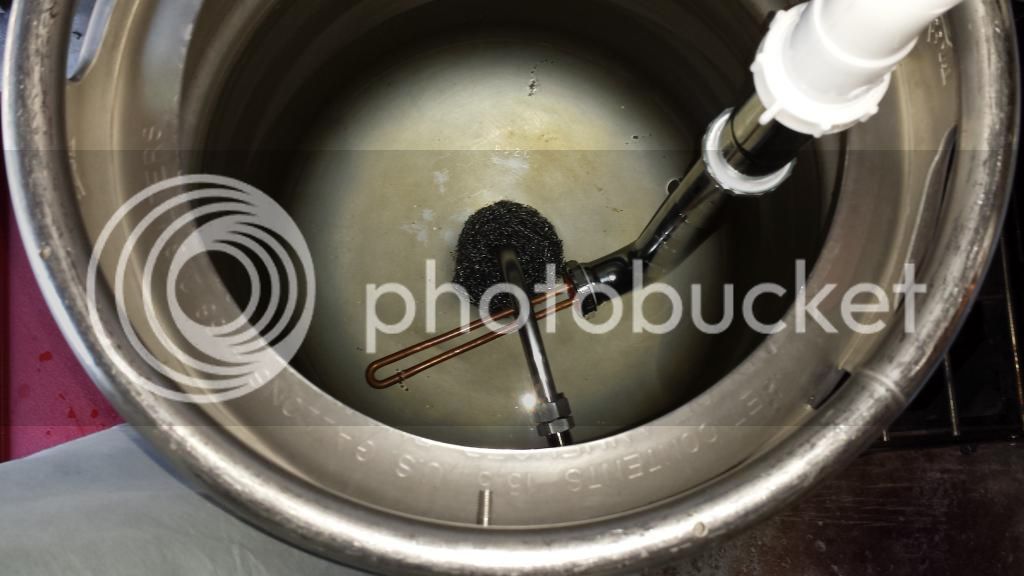
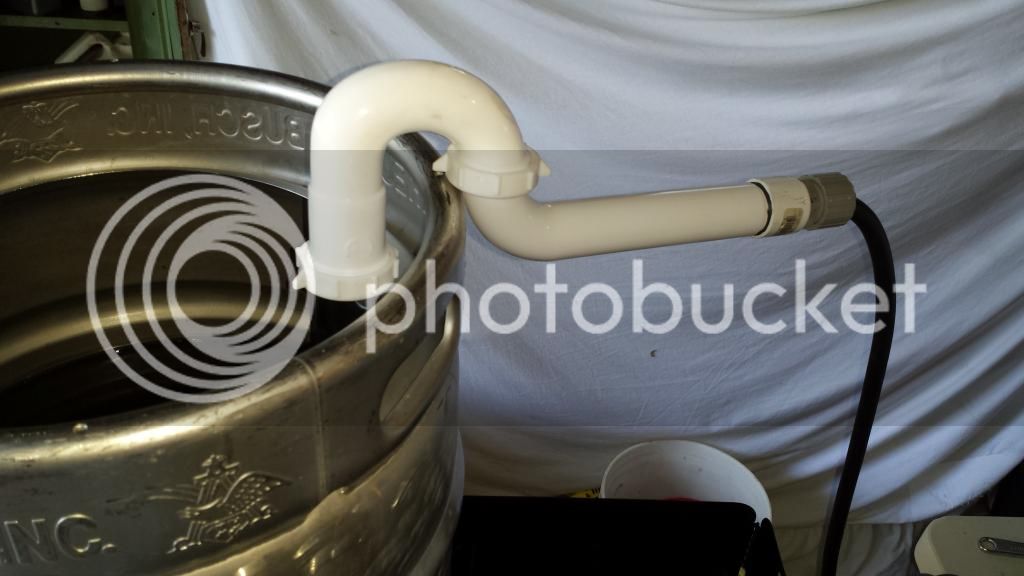
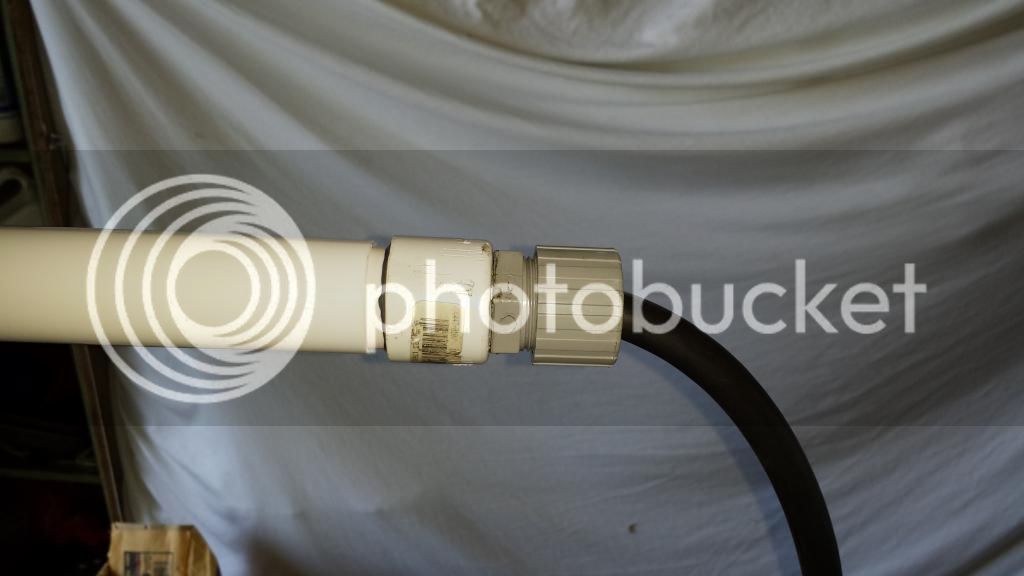
Just enough juice to run the element and pump. :rockin:
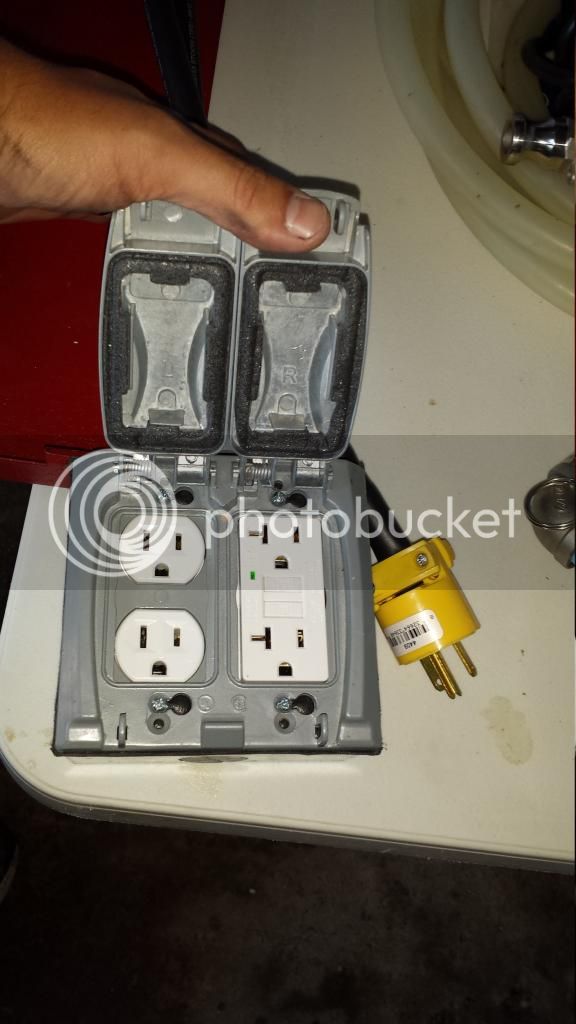
She's alive!!!!
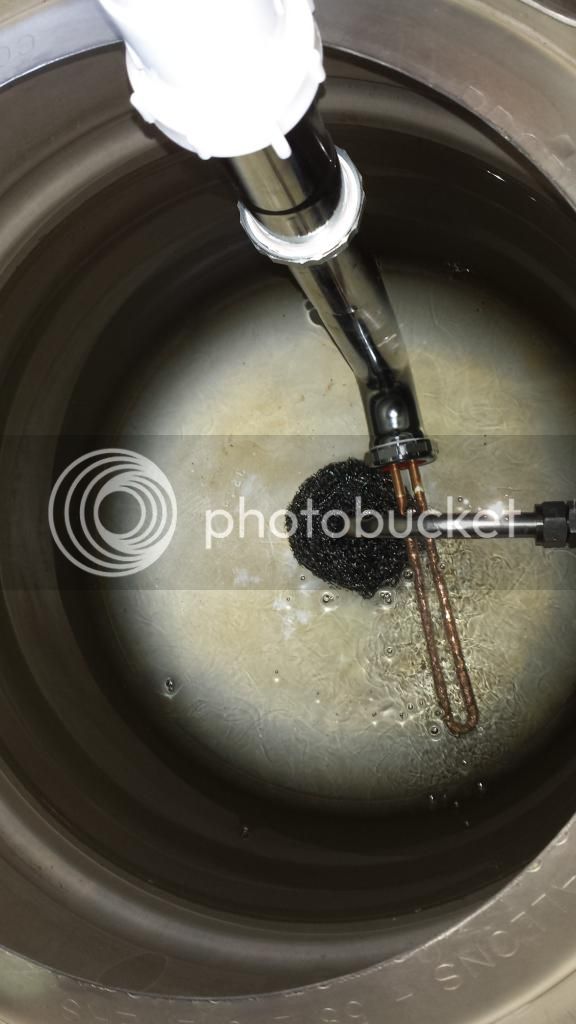
10gal of strike water from 68°F to 170° in 31min with heat stick and propane in keggle! This use to take about an hour or more.
:rockin:



Just enough juice to run the element and pump. :rockin:

She's alive!!!!

10gal of strike water from 68°F to 170° in 31min with heat stick and propane in keggle! This use to take about an hour or more.
:rockin:
This is covered somewhere in this thread...I prefer to splay the ground wire out and fold it back over the threaded portion of the drain tube, when you screw the large cap nut on, the ground wires are crushed in the threaded mechanical connection, then trim off the excess wire.
found it for you....
https://www.homebrewtalk.com/f170/heat-stick-grounding-439100/
This...
I did the same thing and it worked great. There is a lot of play in the threads to allow for this.
so is there any benefit of the 90 degree option? It has been said that direct contact with kettle and element doesn't cause anything which I would see as the only negative for the straight option.
so is there any benefit of the 90 degree option? It has been said that direct contact with kettle and element doesn't cause anything which I would see as the only negative for the straight option.
Mine is 90° and has contact with the dip tube in my keggle...no issues after one boil. Two more scheduled this week, but I also got some 1" lock nuts/o-rings in the mail to get the seal a little more proper.
I would think that maybe the heat rising straight up the the seal on the straight versions would be an issue...maybe that's why some seals are failing?
Mine is 90° and has contact with the dip tube in my keggle...no issues after one boil. Two more scheduled this week, but I also got some 1" lock nuts/o-rings in the mail to get the seal a little more proper.
I would think that maybe the heat rising straight up the the seal on the straight versions would be an issue...maybe that's why some seals are failing?
thanks, yours looks pretty nice, I would prefer the 90, I am thinking of getting a 24" chrome pipe so it is all pipe in the kettle
http://www.amazon.com/dp/B00FL6NAPA/?tag=skimlinks_replacement-20
24" is a bit overkill but I can't find anything between 15 and 24. I think the kettles I'm looking at are 18 or so
Last edited by a moderator:
thanks, yours looks pretty nice, I would prefer the 90, I am thinking of getting a 24" chrome pipe so it is all pipe in the kettle
http://www.amazon.com/dp/B00FL6NAPA/?tag=skimlinks_replacement-20
24" is a bit overkill but I can't find anything between 15 and 24. I think the kettles I'm looking at are 18 or so
Mine is a 16" chrome trap arm, plus a 6" chrome extension so the plastic parts a kept some distance from boiling/steam.
I would have gone with a longer waste arm if there were any at the stores I stopped at. If I see one in the future, I may upgrade. The plastic parts are from a "trap-in-a-bag"...$2.50 for all the plastic. This allowed me to get the cord out away from the propane heat coming up around the keg.
Last edited by a moderator:
wilserbrewer
BIAB Expert Tailor
I have always used straight sticks, and can't really see a benefit to the 90 degree models. I guess I just prefer a more compact device, the 90 degree models with multiple bends become quite large.
The bend around the top of the kettle looks nice, but for all practicality, a straight stick is very secure in the pot, and likely would overturn the kettle prior to inadvertently coming out of the kettle.
JMO
The bend around the top of the kettle looks nice, but for all practicality, a straight stick is very secure in the pot, and likely would overturn the kettle prior to inadvertently coming out of the kettle.
JMO
I have always used straight sticks, and can't really see a benefit to the 90 degree models. I guess I just prefer a more compact device, the 90 degree models with multiple bends become quite large.
The bend around the top of the kettle looks nice, but for all practicality, a straight stick is very secure in the pot, and likely would overturn the kettle prior to inadvertently coming out of the kettle.
JMO
I concur, all the variations are a horse apiece.

Mine is a 16" chrome trap arm, plus a 6" chrome extension so the plastic parts a kept some distance from boiling/steam.
I would have gone with a longer waste arm if there were any at the stores I stopped at. If I see one in the future, I may upgrade. The plastic parts are from a "trap-in-a-bag"...$2.50 for all the plastic. This allowed me to get the cord out away from the propane heat coming up around the keg.
yeah, I'm trying to reduce the amount of parts or points for leakage
so the guy at home depot says that a all GFCI plugs are set to pop at 15 amps, even the 20 amp ones, they will let 20amps flow but once the draw is above 15, they pop. If this is true how are people using the 2000w elements.
This response was that the house is probably not at 120, might be more like 123 or something but it would take getting up to like 140 volts before you got below 15 amps.
This response was that the house is probably not at 120, might be more like 123 or something but it would take getting up to like 140 volts before you got below 15 amps.
so the guy at home depot says that a all GFCI plugs are set to pop at 15 amps, even the 20 amp ones, they will let 20amps flow but once the draw is above 15, they pop. If this is true how are people using the 2000w elements.
This response was that the house is probably not at 120, might be more like 123 or something but it would take getting up to like 140 volts before you got below 15 amps.
I'm not sure the home depot kid is a trustworthy source. GFCI's trip when there is a disparity between the hot leg and the neutral (current is being lost to somewhere). And certainly, a 20a load GFCI is rated to handle 20a draws. I believe what he meant was that a 15a load GFCI will allow pass-through 20a...this type of GFCI is common. Please note that not all of them are 20a pass-through.
High draw situations (like electric motors) may have a higher probability of fluctuations in current (i.e., start-up vs. run), which may lead to nuisance tripping scenarios.
I was hesitant to use my chugger pump and the heat stick at the same time on the same circuit, as it would put me at darn near 20a...I used them both for a whole batch, no problems at all.
I'm not sure the home depot kid is a trustworthy source. GFCI's trip when there is a disparity between the hot leg and the neutral (current is being lost to somewhere). And certainly, a 20a load GFCI is rated to handle 20a draws. I believe what he meant was that a 15a load GFCI will allow pass-through 20a...this type of GFCI is common. Please note that not all of them are 20a pass-through.
High draw situations (like electric motors) may have a higher probability of fluctuations in current (i.e., start-up vs. run), which may lead to nuisance tripping scenarios.
I was hesitant to use my chugger pump and the heat stick at the same time on the same circuit, as it would put me at darn near 20a...I used them both for a whole batch, no problems at all.
Very good to know, thanks!
cantrell00
Well-Known Member
- Joined
- Jul 6, 2013
- Messages
- 840
- Reaction score
- 116
Has anyone successfully controlled a 2000w heat stick with a STC 1000?
Considering that setup as a way to maintain mash. The other thought was to turn the pump on/off to regulate the heat.
Considering that setup as a way to maintain mash. The other thought was to turn the pump on/off to regulate the heat.
Has anyone successfully controlled a 2000w heat stick with a STC 1000?
Considering that setup as a way to maintain mash. The other thought was to turn the pump on/off to regulate the heat.
I am thinking the STC 1000 maxes out at some 5-8 amps or something, but certainly not 15-17
cantrell00
Well-Known Member
- Joined
- Jul 6, 2013
- Messages
- 840
- Reaction score
- 116
I am thinking the STC 1000 maxes out at some 5-8 amps or something, but certainly not 15-17
I also have a Johnson A419. I wonder if it could handle the amperage?
I also have a Johnson A419. I wonder if it could handle the amperage?
I do recall seeing a fellow homebrewer using a Ranco to control his RIMs system so it may be possible, I would stick well under 15 amps though
this says 15 for the A419
http://www.grainger.com/product/JOHNSON-CONTROLS-Electronic-Temperature-Control-36P549
Similar threads
- Replies
- 6
- Views
- 2K














































